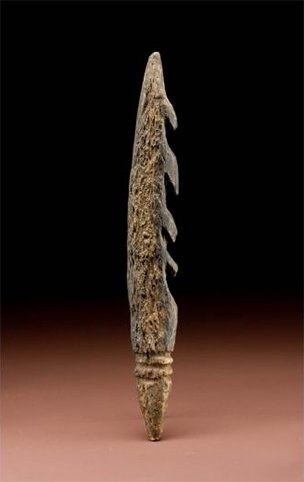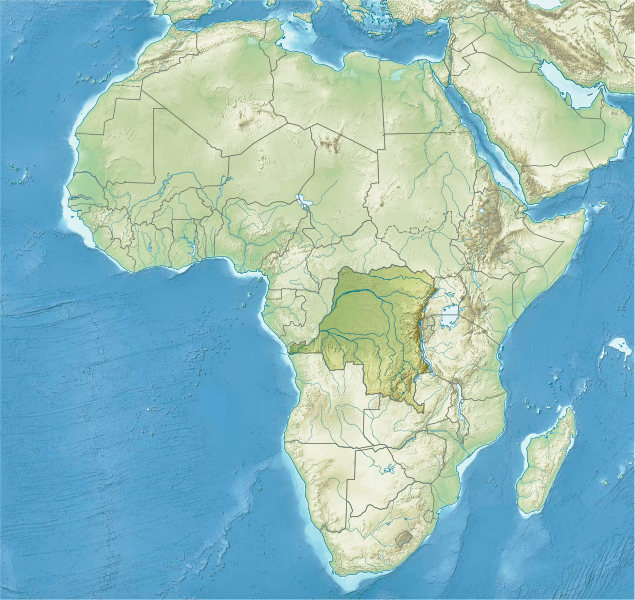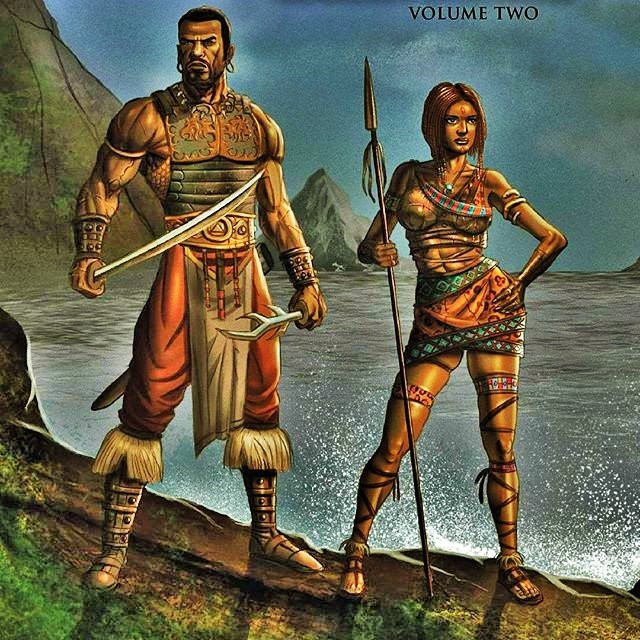This was discovered in 1988 by Alison Brooks and John Yellen in Katanda, Democratic Republic of Congo. Modern humans make special tools for fishing. Humans in Central Africa used some of the earliest barbed points, like this harpoon point, to spear huge prehistoric catfish weighing as much as 68 kg (150 lb)–enough to feed 80 people for two days. Later, humans used harpoons to hunt large, fast marine mammals.
science.sciencemag.org/content

Fishing is an ancient practice in Africa, dating back 100,000 years, when modern humans started moving into coastal environments. The remains of thousands of fish bones and shellfish from sites on the southern African coastline dating to the Middle Stone Age testify to its antiquity. At the same time that human populations in Africa were developing more sophisticated terrestrial hunting technologies, they were also acquiring innovative and productive fishing and riverine hunting skills.

Concomitantly, marine shells were being collected to thread on to twine, probably for use as items of personal ornamentation. Archaeological research has shown that aquatic environments have been exploited for both subsistence and cultural purposes for tens of thousands of years.
Image Credit: Human Origins Program, Smithsonian Institution
The only trouble is, nobody believes them. Sometimes they can’t quite believe it themselves. –discovermagazine.com
The Semliki harpoon, also known as the Katanda harpoon, refers to complex harpoon heads carved from bone. It is from an archaeologic site on the Semliki River in the Democratic Republic of the Congo (formerly Zaire) which dates back 90,000 years.
It seemed to substantiate that fishing and an “aquatic civilization” was likely in the region across eastern and northern Africa during the wetter climatic conditions of the early to mid-Holocene, as shown by other evidence at the lakeshore site of Ishango.
The site is littered with catfish bones and the harpoons are the size to catch adult catfish, so investigators suspect the fisherman came to the site every year “to catch giant catfish.”
It is unlikely that the harpoons are much different from those used today (see reference for photos).
The archaeologic site coincides with the range of the Efé Pygmies, which have been shown by mitochondrial DNA analyses to be one of the oldest races still existing on earth.
discovermagazine.com/1995/aug/theslowcrawlforw
At the Risk of Being Heard: Identity, Indigenous Rights, and …
www.historyofinformation.com/expanded
contemplativecomputing.org/2014/10/when-our-ancestors-became-human-new-evidence

Promotional artwork for Changa and the Jade Obelisk, a fantasy animation project based on the “Changa’s Safari” book series written by Milton Davis. . Called the “African Game Of Thrones” by the writer himself, the team dedicated to bringing this project to life thru animation on Netflix are looking to raise $16,550 in funding for: . 1) Pre-production design . 2) Concept art . 3) Test scene animation . If you would like to donate to this project, click the link in the bio description section of this page. The website includes a promo video for the project. . The admin of this page just donated $105 to this project. I hope you can do the same. . Overview Of Changa’s Safari: . Changa’s story begins in Southwest Africa in the kingdom of Kongo. The only son of the Kabaka (king) Mfumu, Changa was destined to inherit his father’s stool if the ancestors allowed it. But it was not to be. . When Changa was still an 8 year old boy, his father’s stool was taken by the sorcerer Usenge with the aid of the dark magic of the Ndokos. Changa was rushed away to his uncle’s village for his safety and training. Usenge pursued him, forcing Changa to flee alone. . After years of flight he finally settled in Mombasa, first as the bodyguard of the merchant Belay, later as his protégé. But Changa made a vow as a boy, a vow to one day return to his home and revenge his father’s death. . Changa’s Safari is the first step to fulfilling that promise. . .
– Changas-Safari-Milton-J-Davis

[…] Harpooning 80-90,000 years ago In Congo, Africa […]